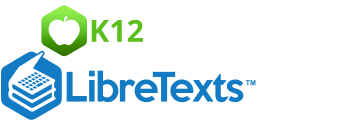9.22: Surface Area and Volume of Cones
- Page ID
- 6303
\( \newcommand{\vecs}[1]{\overset { \scriptstyle \rightharpoonup} {\mathbf{#1}} } \)
\( \newcommand{\vecd}[1]{\overset{-\!-\!\rightharpoonup}{\vphantom{a}\smash {#1}}} \)
\( \newcommand{\dsum}{\displaystyle\sum\limits} \)
\( \newcommand{\dint}{\displaystyle\int\limits} \)
\( \newcommand{\dlim}{\displaystyle\lim\limits} \)
\( \newcommand{\id}{\mathrm{id}}\) \( \newcommand{\Span}{\mathrm{span}}\)
( \newcommand{\kernel}{\mathrm{null}\,}\) \( \newcommand{\range}{\mathrm{range}\,}\)
\( \newcommand{\RealPart}{\mathrm{Re}}\) \( \newcommand{\ImaginaryPart}{\mathrm{Im}}\)
\( \newcommand{\Argument}{\mathrm{Arg}}\) \( \newcommand{\norm}[1]{\| #1 \|}\)
\( \newcommand{\inner}[2]{\langle #1, #2 \rangle}\)
\( \newcommand{\Span}{\mathrm{span}}\)
\( \newcommand{\id}{\mathrm{id}}\)
\( \newcommand{\Span}{\mathrm{span}}\)
\( \newcommand{\kernel}{\mathrm{null}\,}\)
\( \newcommand{\range}{\mathrm{range}\,}\)
\( \newcommand{\RealPart}{\mathrm{Re}}\)
\( \newcommand{\ImaginaryPart}{\mathrm{Im}}\)
\( \newcommand{\Argument}{\mathrm{Arg}}\)
\( \newcommand{\norm}[1]{\| #1 \|}\)
\( \newcommand{\inner}[2]{\langle #1, #2 \rangle}\)
\( \newcommand{\Span}{\mathrm{span}}\) \( \newcommand{\AA}{\unicode[.8,0]{x212B}}\)
\( \newcommand{\vectorA}[1]{\vec{#1}} % arrow\)
\( \newcommand{\vectorAt}[1]{\vec{\text{#1}}} % arrow\)
\( \newcommand{\vectorB}[1]{\overset { \scriptstyle \rightharpoonup} {\mathbf{#1}} } \)
\( \newcommand{\vectorC}[1]{\textbf{#1}} \)
\( \newcommand{\vectorD}[1]{\overrightarrow{#1}} \)
\( \newcommand{\vectorDt}[1]{\overrightarrow{\text{#1}}} \)
\( \newcommand{\vectE}[1]{\overset{-\!-\!\rightharpoonup}{\vphantom{a}\smash{\mathbf {#1}}}} \)
\( \newcommand{\vecs}[1]{\overset { \scriptstyle \rightharpoonup} {\mathbf{#1}} } \)
\( \newcommand{\vecd}[1]{\overset{-\!-\!\rightharpoonup}{\vphantom{a}\smash {#1}}} \)
\(\newcommand{\avec}{\mathbf a}\) \(\newcommand{\bvec}{\mathbf b}\) \(\newcommand{\cvec}{\mathbf c}\) \(\newcommand{\dvec}{\mathbf d}\) \(\newcommand{\dtil}{\widetilde{\mathbf d}}\) \(\newcommand{\evec}{\mathbf e}\) \(\newcommand{\fvec}{\mathbf f}\) \(\newcommand{\nvec}{\mathbf n}\) \(\newcommand{\pvec}{\mathbf p}\) \(\newcommand{\qvec}{\mathbf q}\) \(\newcommand{\svec}{\mathbf s}\) \(\newcommand{\tvec}{\mathbf t}\) \(\newcommand{\uvec}{\mathbf u}\) \(\newcommand{\vvec}{\mathbf v}\) \(\newcommand{\wvec}{\mathbf w}\) \(\newcommand{\xvec}{\mathbf x}\) \(\newcommand{\yvec}{\mathbf y}\) \(\newcommand{\zvec}{\mathbf z}\) \(\newcommand{\rvec}{\mathbf r}\) \(\newcommand{\mvec}{\mathbf m}\) \(\newcommand{\zerovec}{\mathbf 0}\) \(\newcommand{\onevec}{\mathbf 1}\) \(\newcommand{\real}{\mathbb R}\) \(\newcommand{\twovec}[2]{\left[\begin{array}{r}#1 \\ #2 \end{array}\right]}\) \(\newcommand{\ctwovec}[2]{\left[\begin{array}{c}#1 \\ #2 \end{array}\right]}\) \(\newcommand{\threevec}[3]{\left[\begin{array}{r}#1 \\ #2 \\ #3 \end{array}\right]}\) \(\newcommand{\cthreevec}[3]{\left[\begin{array}{c}#1 \\ #2 \\ #3 \end{array}\right]}\) \(\newcommand{\fourvec}[4]{\left[\begin{array}{r}#1 \\ #2 \\ #3 \\ #4 \end{array}\right]}\) \(\newcommand{\cfourvec}[4]{\left[\begin{array}{c}#1 \\ #2 \\ #3 \\ #4 \end{array}\right]}\) \(\newcommand{\fivevec}[5]{\left[\begin{array}{r}#1 \\ #2 \\ #3 \\ #4 \\ #5 \\ \end{array}\right]}\) \(\newcommand{\cfivevec}[5]{\left[\begin{array}{c}#1 \\ #2 \\ #3 \\ #4 \\ #5 \\ \end{array}\right]}\) \(\newcommand{\mattwo}[4]{\left[\begin{array}{rr}#1 \amp #2 \\ #3 \amp #4 \\ \end{array}\right]}\) \(\newcommand{\laspan}[1]{\text{Span}\{#1\}}\) \(\newcommand{\bcal}{\cal B}\) \(\newcommand{\ccal}{\cal C}\) \(\newcommand{\scal}{\cal S}\) \(\newcommand{\wcal}{\cal W}\) \(\newcommand{\ecal}{\cal E}\) \(\newcommand{\coords}[2]{\left\{#1\right\}_{#2}}\) \(\newcommand{\gray}[1]{\color{gray}{#1}}\) \(\newcommand{\lgray}[1]{\color{lightgray}{#1}}\) \(\newcommand{\rank}{\operatorname{rank}}\) \(\newcommand{\row}{\text{Row}}\) \(\newcommand{\col}{\text{Col}}\) \(\renewcommand{\row}{\text{Row}}\) \(\newcommand{\nul}{\text{Nul}}\) \(\newcommand{\var}{\text{Var}}\) \(\newcommand{\corr}{\text{corr}}\) \(\newcommand{\len}[1]{\left|#1\right|}\) \(\newcommand{\bbar}{\overline{\bvec}}\) \(\newcommand{\bhat}{\widehat{\bvec}}\) \(\newcommand{\bperp}{\bvec^\perp}\) \(\newcommand{\xhat}{\widehat{\xvec}}\) \(\newcommand{\vhat}{\widehat{\vvec}}\) \(\newcommand{\uhat}{\widehat{\uvec}}\) \(\newcommand{\what}{\widehat{\wvec}}\) \(\newcommand{\Sighat}{\widehat{\Sigma}}\) \(\newcommand{\lt}{<}\) \(\newcommand{\gt}{>}\) \(\newcommand{\amp}{&}\) \(\definecolor{fillinmathshade}{gray}{0.9}\)Surface area equals the area of the circle plus the area of the outside of the cone
Cones
A cone is a solid with a circular base and sides that taper up towards a vertex. A cone is generated from rotating a right triangle, around one leg. A cone has a slant height.
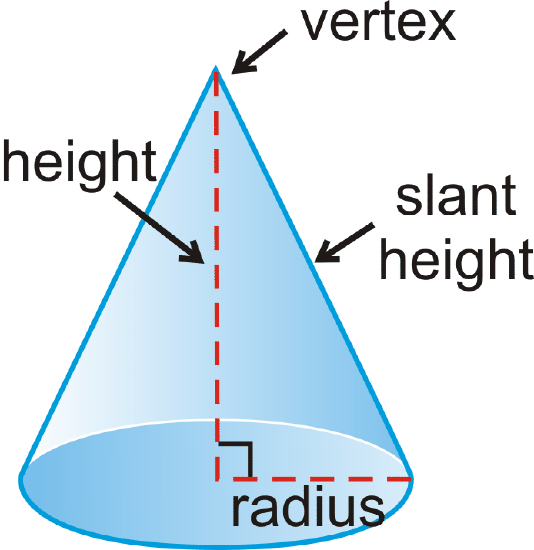
Surface Area
Surface area is a two-dimensional measurement that is the total area of all surfaces that bound a solid. The basic unit of area is the square unit. For the surface area of a cone we need the sum of the area of the base and the area of the sides.
Surface Area of a Right Cone: \(SA= \pi r^{2}+ \pi rl\).
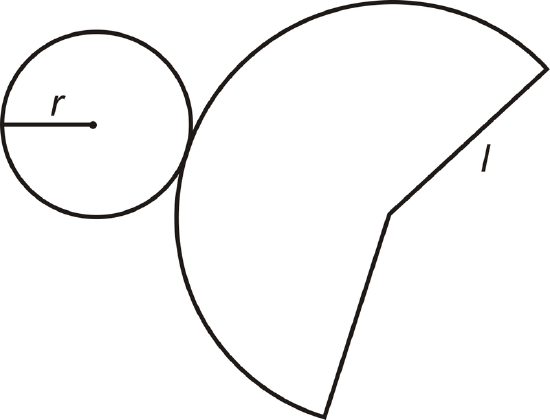
Area of the base: \(\pi r^{2}\)
Area of the sides: \(\pi rl\)
Volume
To find the volume of any solid you must figure out how much space it occupies. The basic unit of volume is the cubic unit.
Volume of a Cone: \(V=\dfrac{1}{3} \pi r^{2} h\).
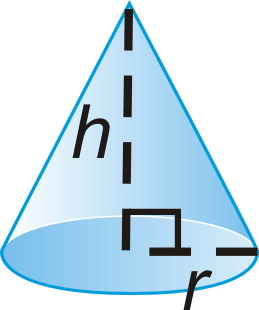
What if you were given a three-dimensional solid figure with a circular base and sides that taper up towards a vertex? How could you determine how much two-dimensional and three-dimensional space that figure occupies?
Example \(\PageIndex{1}\)
The surface area of a cone is \(36 \pi\) and the radius is 4 units. What is the slant height?
Solution
Plug what you know into the formula for the surface area of a cone and solve for \(l\).
\(\begin{aligned} 36 \pi&= \pi 4^{2}+ \pi 4l \\ 36&=16+4l \qquad \text{ When each term has a } \pi \text{, they cancel out.} \\ 20&=4l \\ 5&=l\end{aligned}\)
Example \(\PageIndex{2}\)
The volume of a cone is \(484 \pi \text{ cm}^{3}\) and the height is 12 cm. What is the radius?
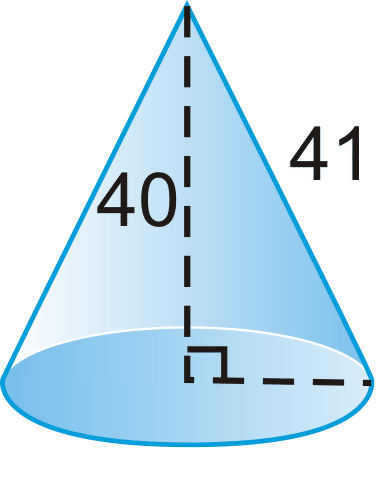
Solution
Plug what you know to the volume formula.
\(\begin{aligned} 484 \pi&=\dfrac{1}{3} \pi r^{2}(12) \\ 121&=r^{2} \\ 11 \text{ cm}&=r\end{aligned}\)
Example \(\PageIndex{3}\)
What is the surface area of the cone?
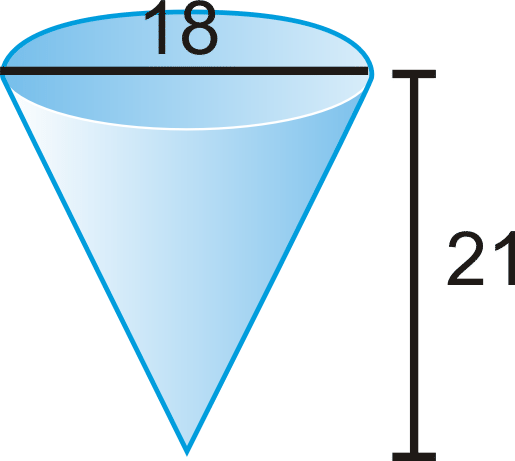
Solution
First, we need to find the slant height. Use the Pythagorean Theorem.
\(\begin{aligned} l^{2}&=9^{2}+21^{2} \\ &=81+441 \\ l&=\sqrt{522}\cong 22.85\end{aligned]\)
The total surface area, then, is \(SA= \pi 9^{2}+ \pi(9)(22.85)\cong 900.54 \text{ units}^{2}\).
Example \(\PageIndex{4}\)
Find the volume of the cone.
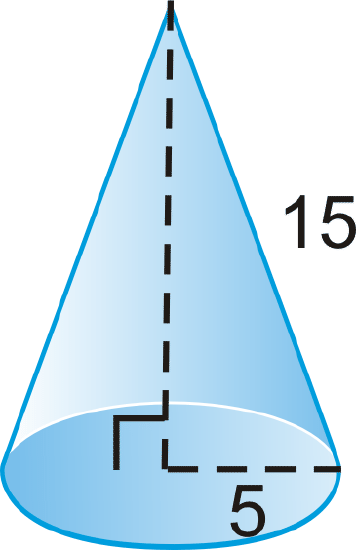
Solution
First, we need the height. Use the Pythagorean Theorem.
\(\begin{aligned} 5^{2}+h^{2}&=15^{2} \\ h&=\sqrt{200}=10\sqrt{2} \\ V&=13(5^{2})(10\sqrt{2}) \pi \cong 370.24 \text{ units}^{3}\end{aligned}\)
Example \(\PageIndex{5}\)
Find the volume of the cone.

Solution
We can use the same volume formula. Find the radius.
\(V=\dfrac{1}{3} \pi(3^{2})(6)=18 \pi \cong 56.55 \text{ units}^{3}\)
Review
Use the cone to fill in the blanks.
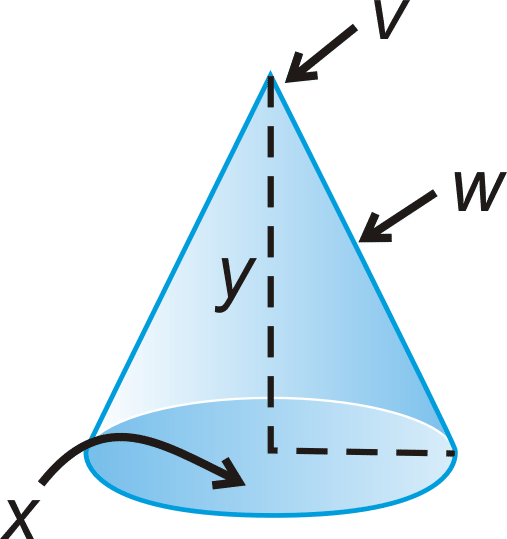
- v is the ___________.
- The height of the cone is ______.
- x is a __________ and it is the ___________ of the cone.
- w is the _____________ ____________.
Sketch the following solid and answer the question. Your drawing should be to scale, but not one-to-one. Leave your answer in simplest radical form.
- Draw a right cone with a radius of 5 cm and a height of 15 cm. What is the slant height?
Find the slant height, \(l\), of one lateral face in the cone. Round your answer to the nearest hundredth.
-
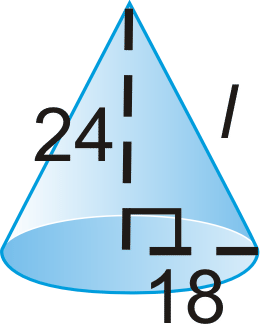
Figure \(\PageIndex{9}\)
Find the surface area and volume of the right cones. Round your answers to 2 decimal places.
-
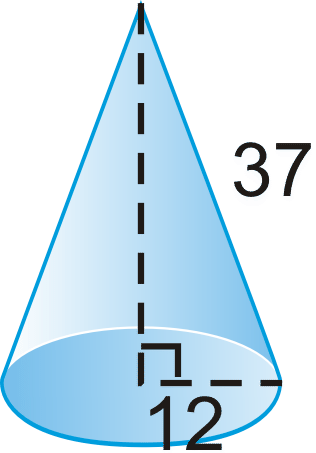
Figure \(\PageIndex{10}\) -
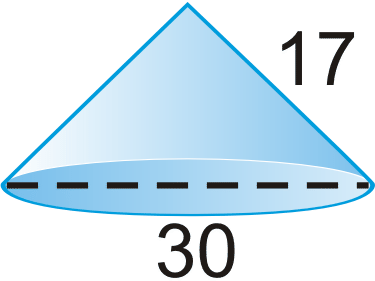
Figure \(\PageIndex{11}\) - If the lateral surface area of a cone is \(30 \pi \text{ cm}^{2}\) and the radius is 5 cm, what is the slant height?
- If the surface area of a cone is \(105 \pi \text{ cm}^{2}\) and the slant height is 8 cm, what is the radius?
- If the volume of a cone is\( 30 \pi \text{ cm}^{3}\) and the radius is 5 cm, what is the height?
- If the volume of a cone is \(105 \pi \text{ cm}^{3}\) and the height is 35 cm, what is the radius?
Review (Answers)
To see the Review answers, open this PDF file and look for section 11.6.
Vocabulary
| Term | Definition |
|---|---|
| cone | is a solid with a circular base and sides that taper up towards a vertex. A cone has a slant height. |
| Slant Height | The slant height is the height of a lateral face of a pyramid. |
Additional Resources
Interactive Element
Video: Surface Area of Cone - Overview
Activities: Cones Discussion Questions
Study Aids: Pyramids and Cones Study Guide
Practice: Surface Area and Volume of Cones

